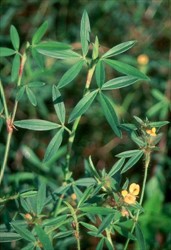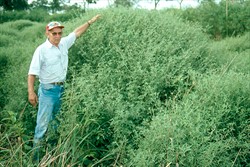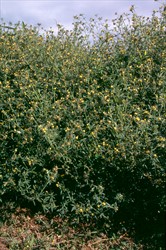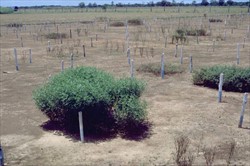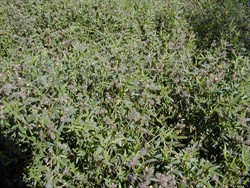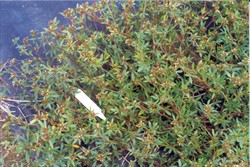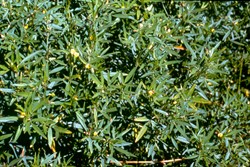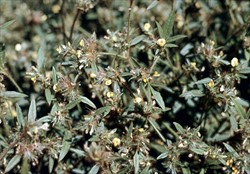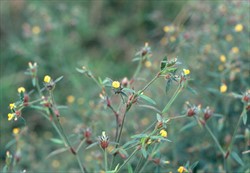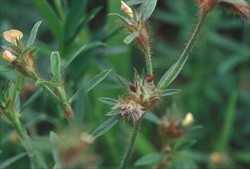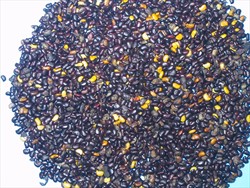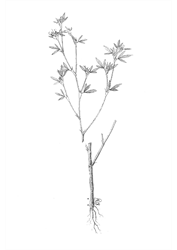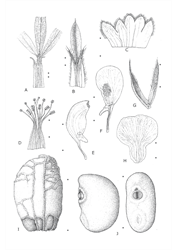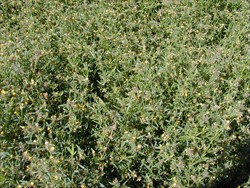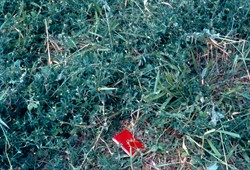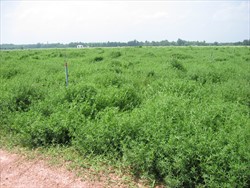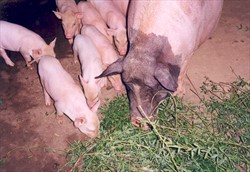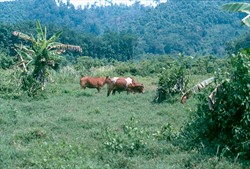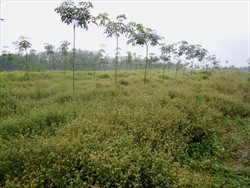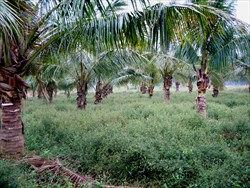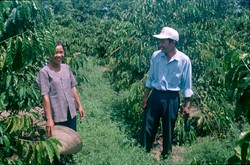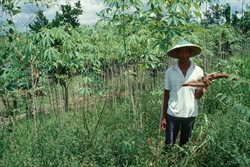Tropical Forages
Stylosanthes guianensis (Aubl.) Sw. var. guianensis
Conspecific taxa:
Stylosanthes guianensis (Aubl.) Sw.
Stylosanthes guianensis (Aubl.) Sw. var. dissitiflora (B.L. Rob. & Seaton) ʼt Mannetje
Stylosanthes guianensis (Aubl.) Sw. var. intermedia (Vogel) Hassl.
Stylosanthes guianensis (Aubl.) Sw. var. longiseta (Micheli) Hassl.
Stylosanthes guianensis (Aubl.) Sw. var. marginata Hassl.
Stylosanthes guianensis (Aubl.) Sw. var. robusta ʼt Mannetje
Basionym: Trifolium guianense Aubl.; Stylosanthes gracilis var. subviscosa (Benth.) Burkart; Stylosanthes guianensis var. canescens M.B. Ferreira & Sousa Costa; Stylosanthes guianensis var. microcephala M.B. Ferreira & Sousa Costa; Stylosanthes guianensis var. pauciflora M.B. Ferreira & Sousa Costa; Stylosanthes guianensis var. subviscosa Benth.; Stylosanthes guianensis var. vulgaris M.B. Ferreira & Sousa Costa.
Note 1: Var. pauciflora above refers to the often so-called 'tardío' type of S. guianensis.
Note 2: In earlier literature, S. guianensis was mistakenly referred to as S. gracilis Kunth. Based on the specimen described by Karl Kunth, Stylosanthes gracilis Kunth is now accepted as a different species with Stylosanthes guianensis var. gracilis (Kunth) Vogel as a synonym. Accordingly, Stylosanthes gracilis auct., non Kunth. could be cited as an additional synonym.
Family: Fabaceae (alt. Leguminosae) subfamily: Faboideae tribe: Dalbergieae subtribe: Stylosanthinae.
A robust perennial herb or sub-shrub, semi-erect to erect, growing to 1.2 m (rarely to 2.5 m) with a strong taproot and small round root nodules. Stem much branched, herbaceous or lignified at the base, indumentum varying from nearly glabrous to densely pilose, often with bristles and viscid. Leaves trifoliolate; petiole 1‒12 mm, rachis 0.5‒1.5 mm long; stipules 2‒15 mm, adnate to the petiole, teeth 2‒10 mm long; leaflets elliptical to lanceolate, 5‒45 mm × 2‒20 mm, not more than 8 times longer than wide, indumentum varying as on stems. Inflorescence a loosely capitate spike, terminal or axillary, with more than 4 flowers. Flower subtended by an outer bract with 3‒7 mm long sheath, a 2.5‒5.5 mm long outer bracteole and a 2‒4.5 mm long inner bracteole; calyx tube 4‒8 mm long, lobes 3‒5 mm; standard 4‒8 mm × 3‒5 mm, yellow to orange, often with black stripes, wings and keel 3.5‒5 mm long. Pod usually 1-jointed, the article ovoid, 2‒3 mm × 1.5‒2.5 mm, glabrous or rarely with very short pubescence, indistinctly veined, with a minute beak, strongly inflexed. Seeds mostly pale brown, varying from yellow to purple or almost black. 250,000‒500,000 seeds per kg.
Asia: 圭亚那笔花豆 gui ya na bi hua dou (China)
English: Brazilian stylo, Brazilian lucerne, Cook stylo, common stylo, stylo
Europe: luzerne brésilienne, luzerne du Brésil, luzerne tropicale (French); brasilianische Luzerne (German)
Latin America: alfafa brasileira, alfalfa-do-nordeste, estilo, estilosantes, trifolio, mangaricão do campo, meladinho, melosa, pegajera, saca estreve, trevo do norte (Brazil); alfalfa brasileña, alfalfa del Brasil, alfalfa tropical, estilosantes, lengua de rana, stylo perenne, tobardillero, tarbardillo, trifolio brasileño (Spanish)
Native:
Northern America: Mexico (Chiapas, Guerrero, Jalisco, Nayarit, Oaxaca, Puebla, Veracruz)
Central America: Costa Rica (n.e.), Guatemala, Honduras, Nicaragua (e.), Panama
South America: Argentina (Córdoba, Corrientes, Misiones), Bolivia (n.), Brazil, Colombia, French Guiana, Guyana, Paraguay, Peru, Suriname, Venezuela
Cultivated/naturalized:
Humid or sub-humid tropics and subtropics.
Forage
Long and short-term grazed pasture systems; also cut-and-carry systems, hay for leaf meal and pellets. Used as feed for ruminants and monogastrics (pigs and fish).
Environment
Intercropping in rice, ground cover (erosion control) in orchards, green manure. Reduced herbicide use when used as ground cover.
Occurs on poor soils in native pastures, scrubland, forest edges, disturbed vegetation.
Soil requirements
Prefers well-drained, open-textured soils from sands to light clays (e.g. tropical latosols, gleys, loams and sandy podzolic soils); poor on heavy montmorillonitic clays. Found on soils with pH from 4.0 to 8.3, adaptation varying with ecotype. Moderately tolerant of high Al and Mn but not of high salinity. 'Tardío' types are more tolerant of high levels of Al and Mn than are the common types. Can extract P very efficiently from low P soils, but still responds to applications of P, as well as K, S, Ca, and Cu in soils with low levels of these nutrients. Needs lower levels of Mo than many other tropical legumes.
Moisture
Occurs in areas with annual rainfall from 700 to 5,000 mm, but mostly from 1,000 to 2,500 mm. Although there are cultivars that in lower rainfall areas can survive long dry periods, they are generally best adapted to regions with >1,500 mm annual rainfall. Tolerance of flooding and short term waterlogging varies with ecotype.
Temperature
The species occurs from about 20º N in Mexico to 32º S in Argentina, and from near sea level to about 2,000 m asl. This equates to a range in average annual temperatures from 23 to 27 ºC down to 19 ºC. Primarily adapted to the hot, humid tropics, although some ecotypes grow satisfactorily in the humid subtropics as well. Tops burnt by frost, but plants generally survive. Adapted mostly to 1,000 m asl, although in some parts of the tropics to 2,000 m.
Light
Considered as having no major shade tolerance, but there are differences among ecotypes. Mostly has limited value in agroforestry.
Reproductive development
Mostly a short-day flowering response with critical photoperiod between 11.5 and 14 hours, depending on ecotype; some ecotypes may require exposure to long days prior to short days for floral initiation. Flowering response is not related simply to latitude or altitude of origin of ecotype. With a particular ecotype, floral initiation occurs earlier with increasing latitude from 4º to 28º, but there is no difference between 28º and 35º. Ecotypes therefore vary in their ability to seed under different day lengths, e.g. the 'tardío' accessions CIAT 10136 and CIAT 1959 gave the highest seed yields at 28º latitude.
Defoliation
Cutting or grazing once plants become tall and woody can kill the plant, since on mature plants there are few growing points close to the ground. Best to stimulate lower branching early by grazing or cutting to 10‒20 cm in the first few months. Constant heavy grazing is detrimental. Grazing on a 1 week on and 4‒8 weeks off rotation, or cutting at 2‒3 month intervals, appears to favour the legume.
Fire
Intolerant of fire. Plants are severely set back by any fire, and killed by "hot" fires, particularly if the soil is dry. With seeds remaining viable in the soil for up to 3 years, significant seed reserves can develop, from which stands can recover after fire. Seed dormancy is broken by fire, stimulating seedling development.
Guidelines for establishment and management of sown forages.
Establishment
Normally planted from seed. Freshly harvested seed may have >70% hard seed. Seed can be scarified to reduce hard seed level by soaking in water at 55 °C for 25 minutes, 70 °C for 10 minutes or at 85 °C for 2 minutes. Alternatively, it can be mechanically scarified with an abrasive disc or rice polisher, or treated with concentrated sulphuric acid for 10 minutes (important to wash seed thoroughly after acid treatment). Mechanical harvesting normally has a scarifying effect on the seed. Fairly promiscuous in its rhizobium requirements, often nodulating adequately on native rhizobium. Commercial inoculant in Australia is based on CB 82 strain Bradyrhizobium, although CB 756 is also effective; MG 5013 is recommended in Malawi. Pelleting is not necessary unless to protect rhizobia from fertilizers. Seed sown at 2‒5 kg/ha. Where seed is scarce, about 80% strike has been achieved with cuttings. Cuttings 15‒20 cm long, with lower leaves removed, are taken in the wet season, and >1/2 the stem buried horizontally to 3‒5 cm.
Fertilizer
Stylo responds well to improved soil fertility, particularly P, but can grow on infertile soil (partly due to endotrophic mycorrhizae found in roots). In deficient soils, 10‒20 kg P/ha is recommended as well as other nutrients as indicated by soil analysis.
Compatibility (with other species)
Can be shaded out by taller grasses such as Megathrysus maximus. Suppresses weeds under correct management. Dies out under excessive cutting or grazing allowing weed to ingress. Has been reported to have an allelopathic effect on weeds and succeeding crops.
Companion species
Grasses: Andropogon gayanus, Chloris gayana, Digitaria eriantha, Heteropogon contortus, Hyparrhenia rufa, Melinis minutiflora, Megathrysus maximus, Paspalum atratum, Cenchrus purpureus , Setaria sphacelata, Urochloa brizantha, Chamaecrista rotundifolia and in more humid environments, Aeschynomene americana. If the pasture is relatively short, it is compatible with Centrosema molle, Macroptilium atropurpureum and Neustanthus phaseoloides.
Pests and diseases
The main diseases are anthracnose caused by Colletotrichum gloeosporioides, and head blight caused by Botrytis cinerea. The former causes "tar spots" on leaves and stems and ultimately kills susceptible varieties. The best control is selection of resistant varieties. Colletotrichum dematium causes similar lesions but is less severe. Botrytis head blight becomes a problem in seed crops during damp weather. While a number of lines tested in Zimbabwe proved resistant to root knot nematode, Meloidogyne javanica, there is record of it and M. arenaria on S. guianensis in Australia. Stem galls caused by Sphaeropsis tumefaciens have been recorded once on 'Mineirão'.
Stemborers, Caloptilia sp. (Lepidoptera) and Platyomopsis pedicornis (Coleoptera) are a problem in many ecotypes in South America (Brazil, Colombia) and Australia (Queensland), respectively.
Ability to spread
Spreads by seed, by virtue of surface water movement or following ingestion by livestock.
Weed potential
Is considered to pose little threat in most situations.
Nutritive value
For a tropical legume, the species is considered to be of medium to fairly high nutritive value with nutrient concentrations varying according to leafiness. Ranges reported are 12‒20% CP, 52‒60 % IVDMD, 0.2‒0.6% P, 0.6‒1.6% Ca.
Palatability/acceptability
Not readily eaten by cattle early in the growing season but becomes relatively more palatable than associated grasses later into the dry or cool season. It is also of value for small ruminants and is can be fed to pigs. With rotational grazing, animals consume the leaves first, successively taking more stem, ultimately damaging the woody main stem. Has some value for deferred grazing since leaf is retained at least in early dry season.
Toxicity
No record of adverse effects.
Feedipedia links
Dry matter
Commonly 5‒10 t DM/ha/yr depending on cultivar, growing conditions and management, and as high as 20 t.
Animal production
Cattle on stylo pastures gain 250‒600 g LW/hd/day; LW production per ha: 300‒500 kg/yr.
2n = 20. Largely self-pollinating with a small percentage of outcrossing. A breeding project S. guianensis “var. vulgaris” × “var. pauciflora”, conducted at Embrapa, Campo Grande, Brazil, yielded intraspecific hybrids subsequently released in Australia as cvv. “Nina” (“Ubon stylo” in Thailand) and “Temprano” (see below).
For cultivars, maximum measured seed production ranges from about 700 to 1,350 kg/ha, although machine harvest recovery is only 50‒60% of this amount since pods shed on maturity. Mechanically harvested commercial crops mostly range between about 100 and 300 kg seed/ha. Late flowering varieties in areas with pronounced dry season require irrigation to complete the reproductive cycle; e.g. 'Mineirão' produced 333 kg/ha seed under irrigation, compared with 82 kg/ha dryland. Seed yields of 'tardío' (= late flowering) types are lower due to limited growing season.
In the upland tropics of Australia, 'Nina' (ATF 3308) commences flowering in March with a peak in April/May, the harvest yielding 260 kg/ha clean dry seed in late June. In the seasonally dry tropics of Thailand, flowering commences September/October and peaks in November and December. By late January, 80‒90% of the seed has fallen. Seed remaining in seed heads is dislodged by beating the crop with bamboo sticks. Seed is then swept up and cleaned, yielding over 1 t/ha on occasions.
Tolerant of 2,4-D; from about 6 weeks of age, at 1.65 kg a.e./ha. Also tolerant of 2,4-DB, acifluorfen, and bentazone, but moderately susceptible to fluazifop-butyl. As with most legumes, stylo is susceptible to metsulfuron-methyl.
- Adapted to acid infertile soils.
- Low P demand.
- Tolerant of Al and Mn.
- Easily established from seed or cutting.
- Growth habit suits cut-and-carry management.
- Used in diverse roles, from grazing systems, cut and carry, erosion control and intercropping.
- Suitable for ruminants and monogastrics.
- Drought tolerance.
- Not persistent under moderate to heavy continuous grazing.
- Frost susceptible.
- A large proportion of the species is susceptible to anthracnose.
Calles, T. and Schultze-Kraft, R. (2010) Re-establishment of Stylosanthes gracilis (Leguminosae) at species level. Kew Bulletin 65:233–240. doi.org/10.1007/s12225-010-9198-z
Chakraborty, S. (ed). (2004) High-yielding anthracnose-resistant Stylosanthes for agricultural systems. ACIAR Monograph No. 111. Australian Centre for International Agricultural Research (ACIAR), Canberra, Australia. aciar.gov.au/node/8471
Costa, N.M.S. and Coradin, L. (2016) Stylosanthes guianensis (Estilosantes). In: Vieira, R.F., Camillo, J. and Coradin, L. (eds) Espécies Nativas da Flora Brasileira de Valor Econômico Atual ou Potencial: Plantas para o Futuro ‒ Região Centro-Oeste. Secretaria de Biodiversidade, Ministério do Meio Ambiente, Brasília, DF, Brazil. p. 561‒571. https://bit.ly/2UMZUzo
Mannetje, L.’t (1992) Stylosanthes guianensis (Aublet) Swartz. In: Mannetje, L.’t and Jones, R.M. (eds) Plant Resources of South-East Asia No. 4. Forages. Pudoc Scientific Publishers, Wageningen, the Netherlands. p. 211–213. edepot.wur.nl/327785
Stace, H.M. and Edye, L.A. (eds). (1984) The biology and agronomy of Stylosanthes. Academic Press, Sydney, Australia. doi.org/10.1016/B978-0-12-661680-4.X5001-X
'Bandeirante' (CIAT 2243, CPI 105921, CPAC 0135) Brazil (1983). A 'tardío' accession with origin Distrito Federal, Brazil (15°46' S, 44°54' W, 1,200 m asl, 1,400 mm/yr). Semi-erect, with average height of 0.65 m. Stems and leaves finely pilose and viscous. Late flowering. Well adapted to poor soils, producing 80% of its maximum yield under 60% aluminium saturation and very low P. Drought tolerant and moderate tolerance of shade and fire.
'CIAT 184' (CPI 133548, ILRI 00164, ATF 493, ATF 2755) Released in Colombia (selected but not released, in the late 1970s). A yellow-seeded variety from Valle del Cauca, Colombia (3°18' N, 960 m asl, 1,840 mm/yr). Erect to semi-erect, to about 1 m tall. Adopted widely in South America, southern China and southeast Asia. It is better adapted to low altitudes (<850 m), soils that are acid (to pH <5.0), have OM contents of less than 3.4% and are moderately sandy (18‒56% sand), with rainfall accumulated in 12 weeks more than 800 mm. Single gene resistance to anthracnose.
'Cook' (CPI 38754, CPI 40368, PI 208547, Q 11075) Released in Australia (1971). Origin near Villavicencio, Colombia (4º N, 410 m asl, 4,000 mm/yr), flowering mid-season, 8 weeks earlier than 'Schofield', at 17º S. Useful for areas of more restricted summer rainfall and shorter growing seasons due to early flowering habit. Vigorous, aggressive, and high yielding at all stages growing well with a range of stoloniferous and tufted grasses. Succumbed to anthracnose type B races 1, 2 and 3.
'Endeavour' (Q 8558) Released in Australia (1971) .From southwest Guatemala (14º N, 1,860 m asl, 2,160 mm/yr). Flowers 2‒4 weeks earlier than 'Schofield' at 17º S, with a longer period of vigorous growth. Lower winter-spring production than 'Cook'. Rapid establishment, early vigour, suited mainly to the high-rainfall coastal areas. Succumbed to anthracnose type B races 1, 2 and 3.
'Graham' (CPI 40255) Released in Australia (1980). From near Santa Cruz, Bolivia (17° S, 440 m asl, 1,350 mm/yr). Flowers earlier than 'Schofield', 'Cook' and 'Endeavour'. High soil seed reserves, seedling density, and plant survival. Succumbed to anthracnose type B race 3.
'Nina', 'Beefbuilder' (ATF 3308, GC 1585, GC 1480); a multiline blend released in Australia (2003). Bred at Embrapa Beef Cattle Research Centre, Campo Grande, Brazil to provide multiple gene resistance to anthracnose, and selected in Brazil. Disease resistance confirmed in Costa Rica, Thailand and tropical Australia. Similar in habit and flowering time to 'CIAT 184'. Since 'Nina' and 'Ubon' are both derived from a mixture of hybrid and wild lines registered in Australia as ATF 3308, they are, in principle, similar. However, seed production has been carried out over a number of generations in contrasting environments in NE Thailand and NE Queensland since 2000, probably resulting in an adaptational genetic shift to the point where they may no longer be considered similar.
'Mineirão' (CIAT 2950, CIAT 10882, CPI 92833, BRA 017817, CNPGC 0984, CPAC 1230, ILRI 15557) Released in Brazil (1993). Tall variety to 2.5 m. Sticky leaves. Recommended in areas up to 1,200 m asl with an annual rainfall above 1,800 mm. Good drought and cold tolerance and resistance to anthracnose. Low seed production.
'Pucallpa' (see 'CIAT 184') Peru (1985).
'Reyan No. 2' ('Bihuadou' ('Zhuhuacao'), 'Pi Hua Dou 184') (see 'CIAT 184') Released in Hainan,China (1991). Grown in citrus and lychee orchards, and cut 2‒3 times/yr (for leaf meal production), with large benefits to tree growth, fruit yield and soil conservation. Produced 5 t DM/ha and over 160 kg seed/ha.
'Reyan No. 5' Released in Hainan, China (2000). Selected from 'CIAT 184'. Earlier flowering, better seed production, anthracnose resistance, and cold tolerance than 'CIAT 184'. Commonly referred to as 'black seed stylo'.
'Reyan No. 7' (CIAT 136, CPI 133549, ILRI 00163) Released in Hainan, China (2000). From near Villavicencio, Colombia (4º16' N, 73º34' W, 480 m asl, 3,530 mm/yr). Selected for DM yield and anthracnose resistance. Similar yield to 'Reyan No. 2' and 'Reyan No. 5', and good winter survival.
'Reyan No. 10' (CIAT 1283, CNPGC 1191, ILRI 00165) Released in Hainan, China (2001). A 'tardío' accession from Maranhão, Brazil (6º02' S, 44º17' W, 440 m asl, 1,400 mm/yr). Selected for anthracnose resistance and long growing period. Better anthracnose resistance, higher yielding and higher CP content than 'Reyan No. 2' or 'Reyan No. 5'. Although late flowering, produces higher seed yields than 'Reyan No. 2'. Tolerance of cold, drought and shade.
'Reyan No. 13' Released in Hainan, China (2003). Unknown CIAT accession (Stylosanthes guianensis contaminant in a seed sample of S. sympodialis CIAT 1044); anthracnose resistance and drought tolerance.
'Reyan No. 18' (BRA 041165, GC 1581) Released in Hainan, China (2007). Selected at Embrapa Campo Grande, Brazil from cv. Mineirão; tolerance of shade, poor soils and drought.
'Reyan No. 20' Released in Hainan, China (2010). Developed from Reyan No. 2 via space flight-induced mutation breeding; disease resistance and tolerance of acid soils, drought and shade.
'Reyan No. 21' Released in Hainan, China (2011). Developed from Reyan No. 2 via space flight-induced mutation breeding; low temperature and drought tolerance.
'Reyan No. 25' Released in Hainan, China (2015). Selected from multiline GC 1585 developed at Embrapa Campo Grande, Brazil; high DM yields, disease resistance and cold tolerance.
'Schofield' (CPI 5630 and others) Released in Australia (pre-1971). Derived from several introductions from Brazil in the 1930s. Good initial performance but succumbed to anthracnose type B.
'Temprano', 'Beefmaker' (ATF 3309, GC 1586, composite of GC 1576 +GC 1524); a multiline blend released in Australia (2003). Bred at Embrapa Beef Cattle Research Centre, Campo Grande, Brazil to provide multiple gene resistance to anthracnose, and selected in Brazil. In the upland tropics of Australia, flowers about 1 month earlier than 'Nina'; early June harvest yielding 330 kg/ha clean dry seed. Less erect growth habit than 'Nina', and better adapted to lower rainfall environments.
'Tha Phra' (see 'CIAT 184') Released in Thailand (1997).
'Ubon stylo' (ATF 3308) Released in Thailand (2002). A blend of four lines (GC 1463, GC 1480, GC 1517, and GC 1579) selected by Dr Bela Grof at the Embrapa Beef Cattle Research Centre, Campo Grande, Brazil in the 1990s. Seed of these four lines was mixed to create greater genetic diversity for durable resistance to anthracnose. Three of the components (GC 1463, GC 1517 and GC 1579) are single-plant selections made in the Philippines by Dr Grof from the hybrid population CIAT 11833, which was selected in the Colombian Llanos by Dr John Miles at CIAT. The fourth component (GC 1480) is from accession CIAT 2340, which originates from the Casanare region of Colombia. Selection for anthracnose resistance was carried out in the Philippines and in regional trials conducted in Brazil. Original seed of ATF 3308 was red, yellow, black and brown, but after many generations of multiplication in Thailand, seed colour is mainly black and yellow with a small proportion of red.
'V8' (mix of 'Nina' and 'Temprano') Marketed in Australia (2000s).
TPRC 2001-84, TPRC 2001-1 Selected in China (Hainan, Yunnan, Guangxi, Guizhou (Xinyi), Sichuan (Pazhihua)). TPRC 2001-84 developed from Reyan No. 2 via space flight-induced mutation breeding; selected for anthracnose resistance and high DM yields.
TPRC 2001-28 Selected in China (Hainan, Yunnan, Guangxi, Guizhou (Xinyi), Sichuan (Pazhihua)) Developed from Reyan No. 2 via space flight-induced mutation breeding; selected for anthracnose resistance, high DM yields and drought tolerance.
MS-146-4 Selected in China (Hainan). A hybrid of var. guianensis CIAT 1979 × var. intermedia (fine-stem stylo; syn. S. hippocampoides Mohlenbr.); in 4th generation genetically stable; selected for cold tolerance and high DM yields.
CIAT 73, CIAT 149, CIAT 1130, CIAT 11732 Selected in China (Hainan, Guizhou (Xinyi)) for cold tolerance (can withstand temperatures from 0 to 5 ℃).
CIAT 145, CIAT 10317 Selected in China (Hainan) for intercropping in orchards (seedling vigour, early ground cover, leafiness and dense branching, low plant height, shade tolerance).
